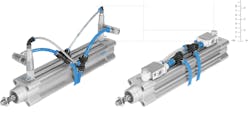You can tell that the industrial sector is active these days by all the design innovation underway. Just look at all the new means of conveyance introduced this year alone. Now another stalwart of the manufacturing industry, the pneumatic actuator control valve, is being revised by one its principal suppliers—Festo.
This new design approach, according to Festo, creates “multi-functional units that are less expensive to purchase than comparable solutions, more than 50 percent smaller in terms of height, save energy, and are easier and faster to install, troubleshoot, and maintain.” The new designs comprise Festo’s new VFOF, VBNF, and VBQF multi-functional pneumatic control valve series.
Space requirements are addressed in the new actuator designs by including component functionality typically bolted on by OEMs. When OEMs add multiple components to actuators, the height of the actuator increases (see photo illustrating an actuator with added components next to an actuator with components included in the design). For example, if an OEM uses a one-way flow control valve for speed control, an air-piloted check valve for stopping cylinder movement and maintaining position, and a manual override valve to release trapped air when servicing, those three different components would have to be bolted on to the actuator.
Also, those additional components increase the potential for compressed air leakage, not to mention associated issues related to ordering and stocking multiple part numbers.
Highlights of Festo’s new actuator series include:
• VFOF (model LE-BAH) provides one-way speed control, manual override, and emergency stop functionality in one actuator unit. According to Festo, the unit bolts to the actuator port and lies flat against the actuator for space savings in terms of height.
• The VBNF control valve delivers emergency stop and manual override in one unit.
• VBQF model features options for manual override with a silencer and manual override without a silencer.
About the Author
David Greenfield, editor in chief
Editor in Chief

Leaders relevant to this article:
